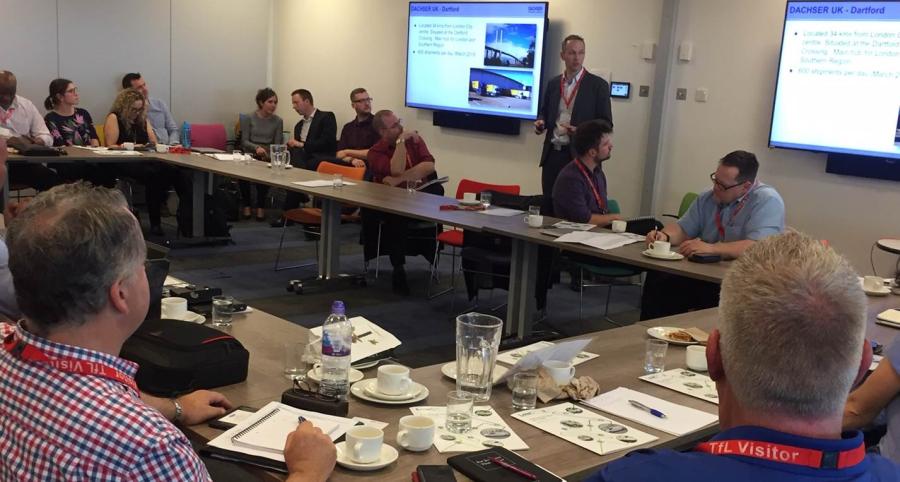Jasmine Matthias meets Thor Johansen of all-electric micro-delivery vehicle Paxster.
‘Saving fifteen minutes an hour in delivery cycles’
LSA at the TfL LoCITY event Palestra House SE1
Jasmine Matthias, taking a look at the keynotes, Dachser and Paxster, from consolidation solutions to time-saving on operational movements of the mini vehicle, it's all electric.
LSA met Sainsbury’s, IKEA, Addison Lee, TNT, Ocado and Rexel amongst a full house road-focused logistics event last week.
Thor Johansen, spoke, ‘operational savings as much as fifteen minutes an hour for delivery in urban locations.’ Global Action Plan (GAP), Martyn Lowder talking Clean Van Commitment, UKPN, Neil Madgwick speaking Electric vehicle work for fleets and predicting less than forty per-cent of future charging will take place at home. Cenex, Chris Rimmer introduced the EFlex project and Dachser, Gabor Nagy delivered a fleet presentation and trial with Zedify that consolidated European deliveries by artic to final mile cargo bike via Hoxton. Great keynote to start, Take a look at the other keynotes below.
Dachser, Gabor Nagy - Talking consolidation to cargo bike and electric van.
‘Reducing morning peak traffic and morning deliveries to be on the shelves by ten am is not easy to find a balance.’ ‘Our target is to deliver zero emission in the congestion zone and reduce number of vans in morning peak. Although reducing morning peak traffic and morning deliveries to be on the shelves by ten am is not an easy balance to find. Evening deliveries should be a part of the solution. Everything we have is on Euro 6, sub-contractors have had Euro 6 for some time, single van operators were the last to transfer to Euro 6. We are trying to reduce vehicles in the congestion zone, our average is heading down. Explaining the Zedify trial, electric vans and cargo bike consolidation, the trial with Zedify is based on the Hoxton depot. Dachser goes into Hoxton depot without entering congestion zone. Package volume is important. Volume is rarely a problem on an artic but for final mile, the difference between claim for 0.1 and reality of 0.2 cubic metres can be challenging as we are limited to circa 1m3 per bike. The next step, first week of June is a further trial where we will drop off to their depot rather than the depot electric van coming to us.
Paxster, Thor Johansen – Paxster in European cities.
Thor was in from environmental capital Oslo, to explain the history of the Paxster business from the Loyds Product range. A history with Norway Post who approached Loyds to help reduce their Carbon footprint, this leading to the birth of the Paxster. Thor, ‘We saw a big win for environment in this market. Trials began in Norwegian snow using Honda scooters where a post person would have as many as fourteen hundred locations a day. From time studies of workforce time it very quickly became clear we needed a four wheel vehicle. A platform to step down easily to the mailbox. We began with a requirement for five postal trays to be loaded, this changed to 15 trays of standard boxes by Royal Mail. Seated on a saddle seat making it really easy to get down to deliver, regulation changes on motor power, in the UK we categorise as a quadra-cycle at 6kW in L6 category. You can keep up-to-speed in traffic in a good way.’
Thor talked motivation for electrifying the delivery fleet, ‘many companies want to do something good and to reduce the CO2. Importantly, companies want to stand out and be seen to be innovative.’ ‘Strong unions in companies in many countries show reluctance to these new-style vehicles.’ ‘Costs, we are confirming suitable areas, the more frequent the stops, the more saving is made, as much as fifteen minutes an hour using the Paxster style vehicle.’ ‘Residual value is always a question, we have not approached private market, this is a single-seat post delivery vehicle, cost around sixteen thousand pounds, range is not an issue for operational cycles in urban areas. The charger is twenty amps to charge the vehicle in eight hours. Customers ask for a quick response to technical problems, we look to have spare parts in the country. Talking compliance, Thor case-studied New Zealand Post, vehicle category and exemptions for use on footpath, road tax etc. Drivers have adapted to being dressed for outside, the vehicle takes strain out of body movements, twisting and turning in a van environment to the easy step-down of the Paxster.
UKPN, Neil Madgwick – Electric vehicle work for fleets
‘trying not to put more copper in the ground.’ ‘predicting less than forty per cent of future charging will be at home.’ Neil, focused on depot charging, connection for business. Today looking at power supply, I am asking for data of your need for charging and locations, I am here to talk cost of depot electrification. Neil spoke UK Power networks, today roughly 63,000 plugged-in cars in our geographic, we are forecasting up to 40 million by 2030. We don’t want to put cables in the ground, we want to look at smart solutions. We are trying to understand clustering of resource geographics. We assume 2.2kW is the average use for a residential house with gas, predicting the infrastructure for electric vehicles is very hard, smart use outside of peak is hard, we are learning use profiles for different users, from home to work and cross sector. We want to know where van drivers are and when they are going to charge - are they charging at home?, on-street fast charger? or at a depot? We predict home charging will be less than forty per-cent in the future, individuals may only charge twice a week.





